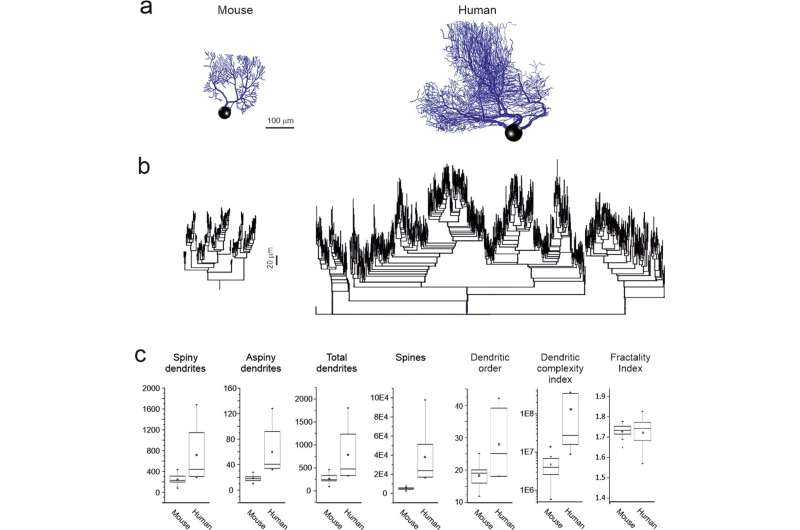January 4, 2024 report
This article has been reviewed according to Science X's editorial process and policies. Editors have highlighted the following attributes while ensuring the content's credibility:
fact-checked
peer-reviewed publication
trusted source
proofread
Comparing human and mouse Purkinje cells to better understand human brain complexity

A multi-institutional team of brain researchers has discovered some of the ways that the human brain has evolved to allow for better cognitive processing by comparing certain nerve cells from the brains of mice and humans. In their project, reported in the journal Communications Biology, the group studied Purkinje cells in the two species.
Purkinje cells (PCs) are a type of neuron cell found in the cerebellum. They are some of the largest and most intricate and are characterized by large numbers of dendritic spines. In this new effort, the research team sought to better understand the evolutionary history of the human brain—or more specifically, to determine the origin of one of the most complicated, intricate and powerful brains to develop in in any animal on Earth.
To that end, the researchers conducted a comparative analysis of PCs collected from human and mouse brains. In addition to taking a very close look at both using microscopes, they also created models to compare how they function in their respective brains and found several differences.
Chief among these differences was the number of dendrites—those in the human brain have approximately 7.5 times as many as those in the mouse brain. The PCs were also larger overall. The research team also found that a higher dendritic complexity of human PCs allowed for larger, more complex and sophisticated neural architectures.
When comparing their models, the researchers found the size and complexity of human PCs allowed for processing more information over a given time than was the case for mouse PCs. This, the researchers suggest, gave the human brain more processing power. The higher number of dendrites also allowed for building networks that were magnitudes of order more complex than was the case for the mice.
The research team suggests one of the ways that humans became so intelligent was through the development of more complicated neurons, such as PCs, which greatly enhanced computational capacity.
More information: Stefano Masoli et al, Human Purkinje cells outperform mouse Purkinje cells in dendritic complexity and computational capacity, Communications Biology (2024). DOI: 10.1038/s42003-023-05689-y
© 2024 Science X Network



















